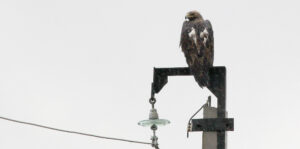Third International Scientific and Practical Conference “Eagles of the Palearctic: Study and Conservation”
Raptors Conservation. Suppl. 2. Proceedings of Conferences
Electrocution Mortality of Imperial Eagle on Medium Voltage Power Lines in Slovakia
Gális M., Slobodník R., Chavko J. (Raptor Protection of Slovakia, Bratislava, Slovakia)
Contact:
Marek Gális galis@dravce.sk
Roman Slobodník slobodnik@dravce.sk
Jozef Chavko chavko@dravce.sk
Recommended citation: Gális M., Slobodník R., Chavko J. Electrocution Mortality of Imperial Eagle on Medium Voltage Power Lines in Slovakia – Causes and Solutions. – Raptors Conservation. 2023. S2: 364–369. DOI: 10.19074/1814-8654-2023-2-364-69 URL: http://rrrcn.ru/en/archives/35142
Medium-voltage power lines are one of the most important mortality factors of raptors in Slovakia. Among the frequent victims of electrocution are also rare species, such as the Imperial Eagle (Aquila heliaca). Many of the breeding pairs have gradually relocated from the foothills to nearby agrocenoses, with a higher risk of possible electrocution, as they often use the poles for resting.
In Slovakia the problem of electrocution has been the focus for mitigation measures since 1991. Especially the LIFE Energy project (implemented in 2014–2019) brought new insight into this topic, as systematic monitoring of almost 61,000 medium voltage poles was carried out in 2014–2016. Electrocution was defined as the main mortality factor of cadavers found. Almost 80% (2,992 individuals, 35 species) of all identified carcasses (4,353 individuals, 84 species) died as a result of electrocution. Branch and anchor supports and poles with jumpers above the insulators were the most dangerous configuration (Fig. 1), accounting for 34.72% of total recorded electrocution fatalities (0.22 carcasses per pole).
Systematic monitoring of the imperial eagle population has been carried out since 1977, when the abundance of the breeding population was 2–10 breeding pairs. After 2000, the settlement of the lowlands and the associated gradual increase in the breeding population were recorded, facilitated by targeted conservation measures. In 2022, the population reached 90 breeding pairs with 108 fledged chicks in Slovakia.
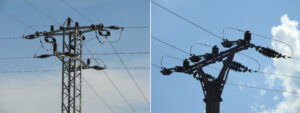
Fig. 1. Branch supports (left) and poles with jumpers above the insulators (right) pose the highest risk of electrocution in Slovakia. Photos from Raptor Protection of Slovakia.
For the period 1993–2022, a total of 28 cases of imperial eagle mortalities were recorded in Slovakia. More extensive monitoring was carried out within the LIFE Energy project (2014–2019) when 16 victims were found, for the other years these are random cases. Therefore the presented numbers do not reflect the actual mortality rate of the imperial eagle on 22 kV lines in Slovakia. The mortalities of individuals were mainly located below the most frequent types of the support poles with pin-type insulators. A serious problem was often observed especially for juveniles and inexperienced individuals during their first flights, landings and take-offs (Fig. 2).
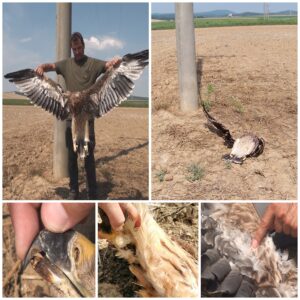
Fig. 2. A juvenile imperial eagle electrocuted while landing on a 22 kV pole. Marks of electrocution on the body indicate the entrance points of an electrical current into the body. Photos from Raptor Protection of Slovakia.
Lowest mortality risk was identified for measures that allow birds to perch safely on the crossarm in comparison to antiperching elements. Therefore, the grid operators started to prefer the use of supports with safe crossarm configurations (for newly constructed lines) or insulating materials and elements that reflect these findings (Fig. 3 and 4).
The 22 kV medium voltage lines consist of thousands of supporting poles. It is therefore important to set the priority areas (breeding sites, feeding areas, etc.) where the main efforts should be focused primarily. This approach is fully implemented within the cooperation between Raptor Protection of Slovakia and DSOs in Slovakia, and also under project LIFE Danube Free Sky1, under which 800 most dangerous poles will be safe for birds.
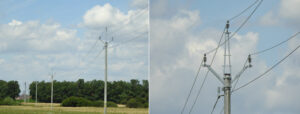
Fig. 3. For newly constructed lines, crossarms with side arms angled upwards are often used. This is both a long-lasting and a very effective measure. Photos from Raptor Protection of Slovakia.
Project is supported by the European Commission under the LIFE programme and the Ministry of the Environment of the Slovak Republic. Satellite transmitters installed on juveniles also help in the identification of priority poles and also bring new insights into the mortality rate (one from six tagged juveniles in 2022 died as a result of electrocution). Prevention of electrocution is especially important in the case of imperial eagle, as the loss of even one individual can have a negative impact on the viability of the local population. Therefore, many identified risky poles are insulated by DSOs on an ad hoc basis. In Slovakia, the protection of wild bird species in relation to their mortality on power lines is required by the national legislation. Only approved protective elements and crossarm designs that have undergone a risk assessment process can be applied. An important aspect of raptor conservation is the communication, mutual trust, and sharing of up-to-date knowledge between all relevant stakeholders.
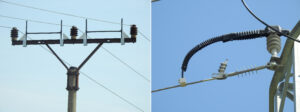
Fig. 4. Insulated landing elements allowing safe perching are often used for supports with pin insulators (left). In the case of more complex designs (anchor or branch supports) covering the conductors and other live elements is mostly preferred (right). Photos from Raptor Protection of Slovakia.

